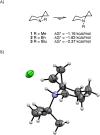Driving tert-butyl axial: the surprising cyclopropyl effect
- PMID: 39449689
- PMCID: PMC11494268
- DOI: 10.1039/d4sc05470a
Driving tert-butyl axial: the surprising cyclopropyl effect
Abstract
The presence of a small spirocyclic ring at an adjacent position alters the conformational preference for equatorial substitution in six-membered rings. DFT calculations and low-temperature 1H NMR experiments demonstrate that alkyl groups larger than methyl possess negative A-values when geminal to a spirocyclopropane, with larger groups such as isopropyl and tert-butyl being exclusively axial at -78 °C. Similar effects are found for heteroatoms, including halogens, and for a range of other electron-withdrawing substituents. Similar effects are observed for other strained rings (epoxide, cyclobutane, oxetane) and the concepts extend to acyclic models as well as heterocycles such as piperidines and piperazines. The origin of the effect is traced to an increase in torsional strain in combination with hyperconjugative effects in the case of electron-poor groups.
This journal is © The Royal Society of Chemistry.
Conflict of interest statement
There are no conflicts to declare.
Figures








Similar articles
-
Hyperconjugation and the increasing bulk of OCOCX3 substituents in trans-1,4-disubstituted cyclohexanes destabilize the diequatorial conformer.J Org Chem. 2006 Jun 9;71(12):4393-9. doi: 10.1021/jo0600858. J Org Chem. 2006. PMID: 16749766
-
Congested ferrocenyl polyphosphanes bearing electron-donating or electron-withdrawing phosphanyl groups: assessment of metallocene conformation from NMR spin couplings and use in palladium-catalyzed chloroarenes activation.Inorg Chem. 2011 Nov 21;50(22):11592-603. doi: 10.1021/ic2015379. Epub 2011 Oct 24. Inorg Chem. 2011. PMID: 22022995
-
Axial Site Occupancy by the Least Electronegative Ligands in Trigonal Bipyramidal Tetraoxyphosphoranes(1).Inorg Chem. 1996 Oct 23;35(22):6552-6560. doi: 10.1021/ic960538z. Inorg Chem. 1996. PMID: 11666804
-
Structure-activity studies of morphine fragments. I. 4-alkyl-4-(m-hydroxy-phenyl)-piperidines.Mol Pharmacol. 1988 Sep;34(3):363-76. Mol Pharmacol. 1988. PMID: 2843751
-
Electronic and steric substituent influences on the conformational equilibria of cyclohexyl esters: the anomeric effect is not anomalous!Chemistry. 2003 Mar 17;9(6):1360-8. doi: 10.1002/chem.200390155. Chemistry. 2003. PMID: 12645025
References
LinkOut - more resources
Full Text Sources

